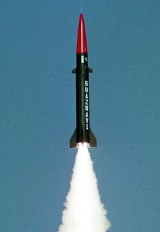
Ghaznavi
Encyclopedia
Ghaznavi Missile is a short range ballistic missile (SRBM) with an optimal range of 290 km, produced by Pakistan
and named after the 11th century Afghan
conqueror Mahmud of Ghazni
. The missile has a length of 9.64m, diameter of 0.99 m, launch weight of 5256 kg and is powered by a single stage solid fuel rocket motor. It is believed to be based on a Chinese design, the M-11 (NATO reporting name: CSS-7).
.
Minister of Information and Culture criticized Pakistan for naming its lethal ballistic missiles and other weaponry after Afghan kings and rulers (i.e. Abdali
, Ghaznavid
, Ghorid and Mughal
rulers) arguing that their names should be bracketed with academic, cultural and peace-promoting institutions, not with tools of destruction and killing. Pakistan declined to change the missiles' names stating that these Muslim rulers are considered heroes in Pakistan as well, and naming missiles after them is not controversial. The Afghan government has not raised this issue since then.
Pakistan
Pakistan , officially the Islamic Republic of Pakistan is a sovereign state in South Asia. It has a coastline along the Arabian Sea and the Gulf of Oman in the south and is bordered by Afghanistan and Iran in the west, India in the east and China in the far northeast. In the north, Tajikistan...
and named after the 11th century Afghan
Afghanistan
Afghanistan , officially the Islamic Republic of Afghanistan, is a landlocked country located in the centre of Asia, forming South Asia, Central Asia and the Middle East. With a population of about 29 million, it has an area of , making it the 42nd most populous and 41st largest nation in the world...
conqueror Mahmud of Ghazni
Mahmud of Ghazni
Mahmud of Ghazni , actually ', was the most prominent ruler of the Ghaznavid dynasty who ruled from 997 until his death in 1030 in the eastern Iranian lands. Mahmud turned the former provincial city of Ghazni into the wealthy capital of an extensive empire which covered most of today's Iran,...
. The missile has a length of 9.64m, diameter of 0.99 m, launch weight of 5256 kg and is powered by a single stage solid fuel rocket motor. It is believed to be based on a Chinese design, the M-11 (NATO reporting name: CSS-7).
Operational history
The Ghaznavi was reported to have been test-launched in late September/early October 2003 and was reported to be ready for service in March 2004. Another test launch occurred in late November 2004, with two more on 9 December 2006 another on 13 February 2008 and 8 May 2010; the 2008 test was believed to have concluded a winter training exercise of Pakistan's Army Strategic Force Command (ASFC)Army Strategic Forces Command (Pakistan)
The Pakistan Army Strategic Forces Command, known as Army SF Command, is major Combatant Command of Pakistan Armed Forces. Together with Pakistan Air Force's Air Force Strategic Command and the Naval Strategic Command , they formed the Pakistan Strategic Forces Commands directly reported to Joint...
.
Criticism
In 2006, the AfghanAfghanistan
Afghanistan , officially the Islamic Republic of Afghanistan, is a landlocked country located in the centre of Asia, forming South Asia, Central Asia and the Middle East. With a population of about 29 million, it has an area of , making it the 42nd most populous and 41st largest nation in the world...
Minister of Information and Culture criticized Pakistan for naming its lethal ballistic missiles and other weaponry after Afghan kings and rulers (i.e. Abdali
Durrani Empire
The Durrani Empire was a Pashtun dynasty centered in Afghanistan and included northeastern Iran, the Kashmir region, the modern state of Pakistan, and northwestern India. It was established at Kandahar in 1747 by Ahmad Shah Durrani, an Afghan military commander under Nader Shah of Persia and chief...
, Ghaznavid
Ghaznavid Empire
The Ghaznavids were a Persianate Muslim dynasty of Turkic slave origin which existed from 975 to 1187 and ruled much of Persia, Transoxania, and the northern parts of the Indian subcontinent. The Ghaznavid state was centered in Ghazni, a city in modern-day Afghanistan...
, Ghorid and Mughal
Mughal Empire
The Mughal Empire , or Mogul Empire in traditional English usage, was an imperial power from the Indian Subcontinent. The Mughal emperors were descendants of the Timurids...
rulers) arguing that their names should be bracketed with academic, cultural and peace-promoting institutions, not with tools of destruction and killing. Pakistan declined to change the missiles' names stating that these Muslim rulers are considered heroes in Pakistan as well, and naming missiles after them is not controversial. The Afghan government has not raised this issue since then.

